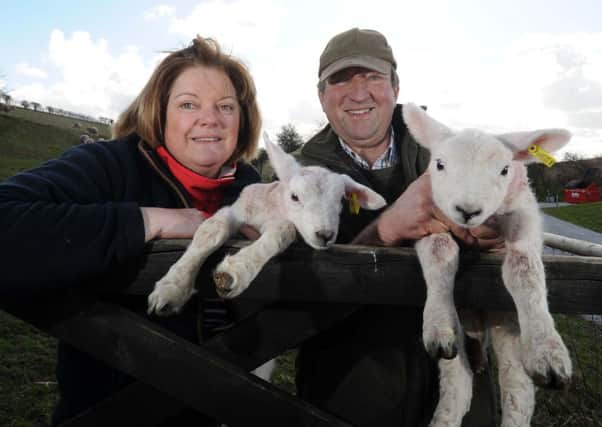Facebook exposure for wigwams on the Flixton farm


This is indicative not of some obsession with this internet creation that many older generations used to consider heathen territory, but because it’s a significant marketing tool in the holiday accommodation business that sits well alongside the livestock and arable enterprise at Humble Bee Farm.
Julia and John Warters run the family farm near Flixton and seven miles from Filey that John’s father and uncle George and Geoffrey came to in 1954. It’s still a working farm that includes fields of wheat, barley and seed potatoes as well as a suckler herd of 40 cows and a flock of 70 pure Texel sheep, but it is wigwams, caravans and holiday cottages that have become a major feature over the past decade.
Advertisement
Hide AdAdvertisement
Hide Ad“Farming really wasn’t very good at one time,” says John. “I remember when grain prices were low and when the effects of foot and mouth disease restrictions took their toll. The big thing was to diversify and we came up with the idea of converting old redundant farm buildings into luxury holiday cottages complete with hot tubs, and a caravan site.”
Julia’s career had involved an 18-year spell as catering manager at the Spa complex in Scarborough.
“One day out of the blue I just thought why I was doing all those hours when I could be putting my skills to better use. We’d lived here for about ten years by then, having moved here from Wold Newton when John began running the farm on his own, and in 2006 we started out with just one cottage.
“We had no reason to believe people would want to come to Humble Bee but we put together a mini website and had an amazing response. All we had was a little caravan site with no facilities and that one cottage. Things started to happen and we decided to get together another two cottages and extend the caravan site including putting up a shower block.
Advertisement
Hide AdAdvertisement
Hide Ad“I was still working full-time at the Spa that first year. I cannot believe how I managed to run both.”
While the holiday cottages, plus the caravan and camping site started putting Humble Bee Farm on the map, it has been the addition of a new and increasingly popular form of holiday accommodation that has seen Julia’s Facebook page increase to over 38,000 likes.
Wigwams, to me, are what the native American Indian tribes of the Sioux and others lived in when I used to watch Westerns on TV. That’s not what these are at all. A wigwam is now a wooden structure that looks like a very small house.
“At first when we started with them I’d get some people ringing to ask whether they could stay in one of our sheds. I got very insulted by that word as I call them cabins more than anything but it looks as though our customers are getting used to them as this year we’re getting requests from prospective visitors actually asking for them by the name wigwam.”
Advertisement
Hide AdAdvertisement
Hide AdWigwams, pods and shepherd’s huts are all now part of the new and sometimes quite cost effective holiday landscape that tend to go under the heading of glamping. So what’s the difference?
“Pods are a lot more basic as they don’t generally have any facilities inside them. Wigwams have raised bedding, heaters and a toaster, microwave, kettle and fridge. That’s where we get bonus points. They’re ideal for mums and dads with toddlers. Many of our bookings are for young families.
“We talk about great holidays in the great outdoors, sitting outside on an evening toasting marshmallows and looking up at the stars. The stays are generally two or three nights and we get stacked out on weekends.
“Those who are booked in to stay here get an opportunity to see first hand what goes on at the farm and in the past three weekends our visitors have been able to see and even take part in lambing. John has an audience every time, even at 11 at night and one evening John asked a lady whether she would like to have a go. She says it is an amazing experience and one that she will never forget.”
Advertisement
Hide AdAdvertisement
Hide AdJohn grows the wheat variety Revelation and the barley variety Concerto. His malting barley goes to Munton’s in Flamborough and is destined for Scottish distilleries for whisky. The seed potatoes are grown by Stockdales under a rental agreement over 30 acres. His Texels and cattle are sold at Malton livestock market.
What John loves most of all about farming is combining the crops: “It’s my highlight of summer. I have a New Holland air-conditioned TX63 and it takes me a couple of weeks to combine the wheat. I like to combine my own corn so that I can set off when it is just right. I let the sun dry the crop.”
John’s love of the countryside has also proved a major boon to the holidaymakers. The farm is run under a Higher Level Stewardship scheme and this has led to a nature walk around the farm where birds such as curlew and lapwings can be spotted due to the inclusion of wild bird mixture strips.
“I love farming as I always have, but I also now really like the razzamatazz of holidaymakers. I love dropping off the fire pits to each of our glampers. They ask about the farm and everyone is intrigued at what a farmer does. You couldn’t possibly do this if you didn’t like people and we do.”